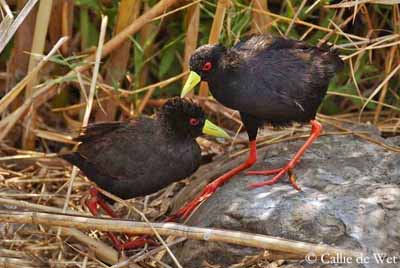Bird’s legs and feet: different shapes
Page 4
Show me your legs, I will know where you are living!
Text by Nicole Bouglouan
Photographers:
Aurélien Audevard
OUESSANT DIGISCOPING
Alfredo Colón
Puerto Rico Wildlife
Paul Guillet
Photos d’Oiseaux
Patrick Ingremeau
TAMANDUA
Eduardo Andrés Jordan
MIS AVES – AVES DE ARGENTINA
René Lortie
http://rlortie.ca
Eugène Montocchio
Galerie Photos Nature
Jean Michel Peers
JMPN PHOTOGRAPHIE
Callie de Wet
GALLERY
Philippe et Aline Wolfer
GALERIE
Nicole Bouglouan
PHOTOGRAPHIC RAMBLE
Sources:
Wikipedia (Wikipedia, The Free Encyclopedia)
Welcome to Avian Anatomy and Morphology
The Earthlife Web
We find several other birds’ species living in aquatic areas, such as the Rallidae (rails, coots, moorhens, crakes, swamphens), the Jacanidae (jacanas) and the Podicipedidae (grebes).
All these birds have peculiar non-webbed feet, but the toes are equipped with fleshy lobes or loose membranes, especially in some Rallidae and Podicipedidae.
The Jacanidae show very long, thin toes with peculiar use.


The grebes have short legs situated far towards the lower belly. Each toe is equipped with loose fleshy membrane which stretches under the water pressure when the bird is swimming.
However, if they swim very well, they are very clumsy on the ground.




The long toes distribute the weight regularly among both feet, allowing the bird to move easily in this way in aquatic areas.
The long legs are used when foraging in deeper muddy water.

The Rallidae share their time between the water, the mud and the ground. They often forage among the aquatic vegetation of the shores, and their slim body make easier to worm their way into the reeds.
The moorhens have shorter legs than jacanas, but their feet are very similar, slightly shorter but with thin toes. They occur in aquatic areas with floating vegetation and swim very well.

The rails have strong, long legs equipped with robust, long toes, but shorter than in Jacanas. They can swim if necessary.



The crakes have similar behaviour, but they are slightly smaller with shorter legs.

The swamphens are larger birds with robust legs and feet. They have similar behaviour and forage in aquatic areas, between the reeds and the vegetation, but also in drier areas.


The coots have relatively short legs compared to the other species, but their feet are unique. Each toe is equipped with a series of fleshy lobes, and the underside is flat, allowing the bird to swim, but also to run and walk on the mud, the ice or the ground. They have three toes forwards and one backwards.
They swim effortless. They often fight in the water with other coots, and at this moment, the feet are used as weapon.
All these species have almost similar behaviour and frequent the same type of habitats. The differences between the legs’ size and the feet shapes allow them to feed in different water depths, with floating vegetation or vegetated shores.